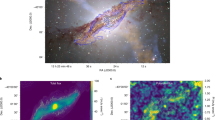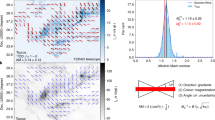Abstract
Magnetic fields play an important (sometimes dominant) role in the evolution of gas clouds in the Galaxy, but the strength and orientation of the field in the interstellar medium near the heliosphere has been poorly constrained. Previous estimates of the field strength range from 1.8–2.5 μG and the field was thought to be parallel to the Galactic plane1 or inclined by 38–60° (ref. 2) or 60–90° (ref. 3) to this plane. These estimates relied either on indirect observational inferences or modelling in which the interstellar neutral hydrogen was not taken into account. Here we report measurements of the deflection of the solar wind plasma flows in the heliosheath4 to determine the magnetic field strength and orientation in the interstellar medium. We find that the field strength in the local interstellar medium is 3.7–5.5 μG. The field is tilted ∼20–30° from the interstellar medium flow direction (resulting from the peculiar motion of the Sun in the Galaxy) and is at an angle of about 30° from the Galactic plane. We conclude that the interstellar medium field is turbulent or has a distortion in the solar vicinity.
This is a preview of subscription content, access via your institution
Access options
Subscribe to this journal
Receive 51 print issues and online access
$199.00 per year
only $3.90 per issue
Buy this article
- Purchase on Springer Link
- Instant access to full article PDF
Prices may be subject to local taxes which are calculated during checkout



Similar content being viewed by others
References
Frisch, P. C. LISM structure-fragmented superbubble shell? Space Sci. Rev. 78, 213–222 (1996)
Lallement, R. et al. Deflection of the interstellar neutral hydrogen flow across the heliospheric interface. Science 307, 1447–1449 (2005)
Opher, M., Stone, E. C. & Gombosi, T. I. The orientation of the local interstellar magnetic field. Science 316, 875–878 (2007)
Richardson, J. D. et al. Cool heliosheath plasma and deceleration of the upstream solar wind at the termination shock. Nature 454, 63–66 (2008)
Pogorelov, N. V. & Zank, G. P. The direction of the neutral hydrogen velocity in the inner heliosphere as a possible interstellar magnetic field compass. Astrophys. J. 636, L161–L164 (2006)
Opher, M., Stone, E. C. & Liewer, P. C. The effects of a local interstellar magnetic field on Voyager 1 and 2 observations. Astrophys. J. 640, L71–L74 (2006)
Opher, M., Richardson, J. C., Toth, G. & Gombosi, T. I. Confronting observations and modeling: the role of the interstellar magnetic field in Voyager 1 and 2 asymmetries. Space Sci. Rev. 143, 43–55 (2009)
Pogorelov, N. V., Stone, E. C., Florinski, V. & Zank, G. P. Termination shock asymmetries as seen by the Voyager spacecraft: the role of the interstellar magnetic field and neutral hydrogen. Astrophys. J. 668, 611–624 (2007)
Pogorelov, N. V., Heerikhuisen, J. & Zank, G. P. Probing heliospheric asymmetries with an MHD-kinetic model. Astrophys. J. 675, L41–L44 (2008)
Stone, E. C. et al. An asymmetric solar wind termination shock. Nature 454, 71–74 (2008)
Stone, E. C. et al. Voyager 2 explores the termination shock region and the heliosheath beyond. Science 309, 2017–2020 (2005)
Izmodenov, V. V. Local interstellar parameters as they are inferred from analysis of observations inside the heliosphere. Space Sci. Rev. 143, 139–150 (2009)
Minter, A. H. & Spangler, S. R. Observation of turbulent fluctuations in the interstellar plasma density and magnetic field on spatial scales of 0.01 to 100 parsecs. Astrophys. J. 458, 194–214 (1996)
Jokipii, J. R. Our interstellar neighborhood. Science 307, 1424–1425 (2007)
Frisch, P. C. et al. The galactic environment of the Sun: interstellar material inside and outside the heliosphere. Space Sci. Rev. 146, 235–273 (2009)
Linsky, J. L. Solving the mysteries of the diffuse interstellar medium with high-resolution UV spectroscopy. Astrophys. Space Sci. 320, 85–90 (2009)
Redfield, S. & Linsky, J. The structure of the local Interstellar Medium. IV. Dynamics, morphology, physical properties, and implications of cloud-cloud interactions. Astrophys. J. 673, 283–314 (2008)
Cox, D. & Helenius, L. Flux-tube dynamics and a model for the origin of the local fluff. Astrophys. J. 583, 205–228 (2003)
Jenkins, E. B. & Tripp, T. M. The distribution of thermal pressures in the interstellar medium from a survey of CI fine-structure excitation. Astrophys. J. Suppl. Ser. 137, 297–340 (2001)
Shelton, R. et al. The local bubble debate. Report from sessions 1 and 3. Space Sci. Rev. 143, 303–309 (2009)
Jenkins, E. B. Pressure and ionization balances in the circum-heliospheric interstellar medium and the local bubble. Space Sci. Rev. 143, 205–216 (2009)
Izmodenov, V. V., Malama, Y. G. & Ruderman, M. S. Modeling of the outer heliosphere with the realistic solar cycle. Adv. Space Res. 41, 318–324 (2008)
Richardson, J. D., Liu, Y. & Wang, C. Solar wind structure in the outer heliosphere. Adv. Space Res. 41, 237–244 (2008)
Acknowledgements
We thank the staff at NASA Ames Research Center for the use of the Columbia supercomputer. M.O. and F.A.B. acknowledge the support of NASA and the National Science Foundation. J.R. is supported by the Voyager project. V.V.I. acknowledges the support of the Russian Agency of Science and the Dynastia Foundation. We thank E. C. Stone and R. Shelton for suggestions and comments.
Author Contributions M.O. ran the models and wrote the paper. F.A.B. performed the R-H calculations, the model flow calculations, and participated in the writing of the paper. J.D.R. analysed the plasma data. G.T. helped implement the five-fluid magnetohydrodynamic model. V.V.I. assisted in the theoretical discussions, including solar cycle effects. T.I.G. provided assistance with the global magnetohydrodynamic model.
Author information
Authors and Affiliations
Corresponding author
Supplementary information
Supplementary Information
This file contains Supplementary Data, Supplementary Table 1, a Supplementary Discussion, Supplementary References and Supplementary Figures S1-S4 with Legends. (PDF 696 kb)
Rights and permissions
About this article
Cite this article
Opher, M., Bibi, F., Toth, G. et al. A strong, highly-tilted interstellar magnetic field near the Solar System. Nature 462, 1036–1038 (2009). https://doi.org/10.1038/nature08567
Received:
Accepted:
Issue Date:
DOI: https://doi.org/10.1038/nature08567
This article is cited by
-
Turbulence in the Outer Heliosphere
Space Science Reviews (2022)
-
The Structure of the Large-Scale Heliosphere as Seen by Current Models
Space Science Reviews (2022)
-
The Heliosphere and Local Interstellar Medium from Neutral Atom Observations at Energies Below 10 keV
Space Science Reviews (2022)
-
A small and round heliosphere suggested by magnetohydrodynamic modelling of pick-up ions
Nature Astronomy (2020)
-
Magnetic field and particle measurements made by Voyager 2 at and near the heliopause
Nature Astronomy (2019)
Comments
By submitting a comment you agree to abide by our Terms and Community Guidelines. If you find something abusive or that does not comply with our terms or guidelines please flag it as inappropriate.



